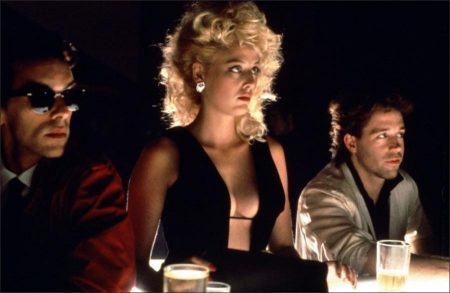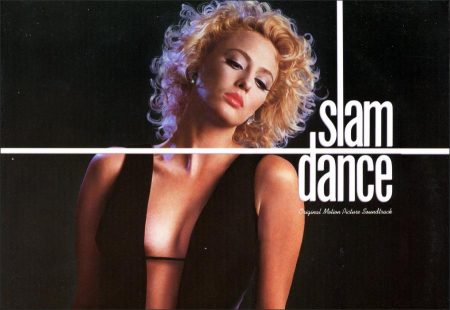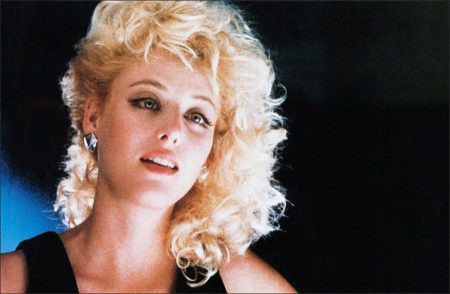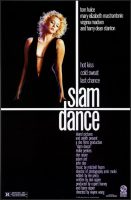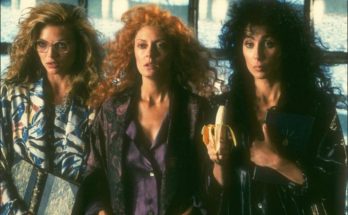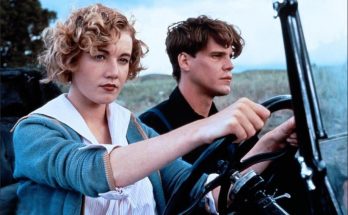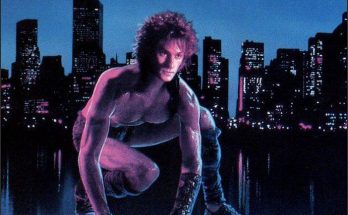Taglines: Hot kiss. Cold sweat. Last dance.
Slam Dance movie synopsis. A married cartoonist named C.C. Drood becomes involved in the cover up of a political sex scandal after his lover, Yolanda Caldwell, a call girl, is found murdered. Drood has betrayed his wife Helen with the exotic Yolanda, who takes him to a club where the patrons slam dance, violently crashing into one another on the dance floor.
Bobby Nye, a former lesbian lover of Yolanda’s, hires a hit man named Buddy to do away with Drood, who is also hotly pursued by the police. Drood ultimately comes to believe that Bobby and Buddy are the ones responsible for Yolanda’s death. A corrupt cop, Gilbert, is doing everything in his power to pin the whole thing on Drood, but a police colleague, Smiley, intervenes on the wanted man’s behalf.
Slam Dance is a 1987 thriller directed by Wayne Wang and starring Tom Hulce, Mary Elizabeth Mastrantonio, Virginia Madsen, Don Keith Opper, Adam Ant, Harry Dean Stanton, Millie Perkins, Judith Barsi and Rosalind Chao. It was screened out of competition at the 1987 Cannes Film Festival.
Interview with Wayne Wang
Amy Tan’s debut novel, “The Joy Luck Club,” emerged in 1989 as a major critical and commercial success, but it frightened the movie studios. Virtually all the central characters were Chinese women, there was a mosaic of interwoven stories of mothers and daughters, and the settings were San Francisco and China. There was simply no precedent for a mainstream Hollywood film with an all-Asian cast.
Moreover, Wayne Wang, perhaps the foremost Chinese-American film maker and the obvious choice to direct, was reluctant to do so. “I didn’t want to do another Chinese movie,” said the bespectacled, 44-year-old Mr. Wang. “I said for years that I was being stereotyped. Yet I loved the book. The stories reminded me so much of the stories I heard from my parents, and I felt the book transcended just being Chinese.”
At the request of his agent, Mr. Wang met Ms. Tan for tea at the Clift Hotel in San Francisco in 1989. Ms. Tan herself was nervous about turning her novel into a film. “The project scared Wayne, and it scared me,” she said. “He was hesitant. It wasn’t this gushing sense that I got from everybody else. People from studios said they loved the book, but when I asked, ‘How do you see doing it as a film?’ they’d say, ‘I don’t know. I just want to do it.’ ”
Out of this uncertain beginning, “The Joy Luck Club” has been turned into an ambitious, multilayered film that opens on Wednesday. The best-known cast member is France Nuyen, who played Bloody Mary’s nubile daughter, Liat, in the film version of “South Pacific” in 1958, when she also originated the title character in the Broadway play “The World of Suzie Wong.” Produced by Hollywood Pictures, a division of Walt Disney Studios, “The Joy Luck Club was filmed largely in Northern California and China” for a relatively low $10.5 million.
The movie, like the novel, is about the bonds and mysteries that envelop mothers and daughters. The mothers here are powerful Chinese women who have prospered in San Francisco and whose apparently placid lives mask the tragic dramas that shaped their earlier years in China. By contrast, the lives of their American daughters seem almost ordinary. The screenplay was written by Ms. Tan and Ronald Bass, whose writing credits include “Black Widow,” “Sleeping With the Enemy” and “Rain Man,” for which he shared an Academy Award with Barry Morrow.
Mr. Wang and Ms. Tan credit Mr. Bass with playing a significant role in turning the novel into a film. “He discussed the book very intricately, as though he had analyzed it,” said Ms. Tan. “I felt as though he was a psychiatrist telling me about my life. I don’t analyze my books that way.”
The consensus at many studios was that the characters and plot were too internal and complex to transfer to the screen. Although he maintained the plot line, Mr. Bass made two important changes. He created a “wraparound,” a device that threads through the film — in this case, a farewell party for a young woman leaving for China. Mr. Bass also used voice-overs to compress the time that each of the characters would have to tell their stories.
“A lot of executives and producers are afraid of voice-overs because they say it distances the audience from the action,” said Mr. Bass. “I felt differently. It allowed you into the inner heart of the narrator. It allowed you to understand their feelings in a way you could never do in dialogue.”
The project’s godparents were the film maker Oliver Stone and Janet Yang, vice president of production for Ixtlan, Mr. Stone’s production company. The two, who are credited as executive producers, helped propose the movie to Jeffrey Katzenberg, chairman of Walt Disney Studios. The studio, which has a reputation for intrusiveness on projects, largely left the film makers alone.
“At the first meeting, Jeffrey Katzenberg said these magic words: ‘We want you to make your movie; we want you to trust your intuition,’ ” said Ms. Tan. “I thought, ‘Sure, we’ll see how they really act.’ But I was surprised. They had suggestions, but they kept saying, ‘You guys make the movie you want.’ ”
The director, whose career has veered between the fringe and the mainstream, has been almost entirely identified with Chinese-American films. His first, “Chan Is Missing,” made in 1982 for $22,000, dealt humorously and poignantly with immigrants’ problems. It was a critical and commercial success. His second film, “Dim Sum” (1984), centered on the relationship between a Chinese mother and her American-born daughter. “Slamdance” (1987), starring Tom Hulce and Mary Elizabeth Mastrantonio, was his only movie not to deal with the Chinese. It didn’t do well, and he followed it with the 1989 screwball comedy “Eat a Bowl of Tea,” about newlyweds in 1949. (One of the stars, Cora Miao, is Mr. Wang’s wife.)
In 1990, Mr. Wang returned to his birthplace, Hong Kong, to make what he calls “a really down-and-dirty offbeat film,” with the provocative title “Life Is Cheap . . . but Toilet Paper Is Expensive.”
Most of his movies have been well received by critics. But he is dismayed at being defined largely as an Asian film maker. “Any time someone wanted to do a film in China or Hong Kong, or about gangs in Chinatown, I was offered those,” he said. “The only area of interest for the studios is the gangs, the Triads, the John Woo sort of stuff. That’s the only area they feel they can exploit. It’s sad that what the American community knows about the Chinese is really bad.”
But Mr. Wang acknowledges that, compared to other minorities, Chinese-Americans have never tapped into the movie business. “It’s hard to get money from the Chinese community to support film,” he said. “It’s not part of the blood system. Whereas if you tell them you have a piece of real estate or a business to sell, they’re great. We love going to movies but don’t want to be part of it.
“I’m going to stereotype them, but the Chinese are very practical,” he added, smiling. “They want to own their own property, their own business. And movies are so nebulous — like a dream, a fantasy.”
Mr. Wang has firsthand experience of this ambivalence toward the arts. His father was a Hong Kong businessman who grew up in China, worked at an American Air Force base during World War II and named his son after a Hollywood actor. “My father named me after seeing John Wayne in ‘Red River,’ ” Mr. Wang said. “What appealed to him, I think, was the freedom and righteousness, the whole American mentality. My father loved to play football. He loved anything American.”
Mr. Wang attended Roman Catholic schools in Hong Kong, then came to the United States to study painting but switched to film making and earned a master’s degree in film and television from the California College of Arts and Crafts in Oakland. “My parents wanted me to go into medicine or become an engineer,” he said. “My parents said, ‘Oh, no!’ when I went into art. I lived mostly on scholarships. When I got into film, my dad was actually glad because he loved movies so much; and he said at least I wasn’t going to be a painter starving in the streets.”
Mr. Wang describes his next project, “Smoke,” as a “strange Christmas story,” by the novelist Paul Auster. “I definitely want to step away from the Chinese thing for a while,” said Mr. Wang. “I’ll eventually get back to it — I’m sure I will — but at the same time, I feel I’m just as American as anyone else. There are stories and characters about America that I want to tell.”
Slam Dance (1987)
Directed by: Wayne Wang
Starring: Tom Hulce, Mary Elizabeth Mastrantonio, Virginia Madsen, Don Keith Opper, Adam Ant, Harry Dean Stanton, Millie Perkins, Judith Barsi, Rosalind Chao
Screenplay by: Don Keith Opper
Production Design by: Eugenio Zanetti
Cinematography by: Amir Mokri
Film Editing by: Sandy Nervig, Lee Percy
Costume Design by: Malissa Daniel
Set Decoration by: Michael Marcus
Art Direction by: Philip Dean Foreman
Music by: Mitchell Froom
Distributed by: Island Pictures
Release Date: October 2, 1987
Views: 276
